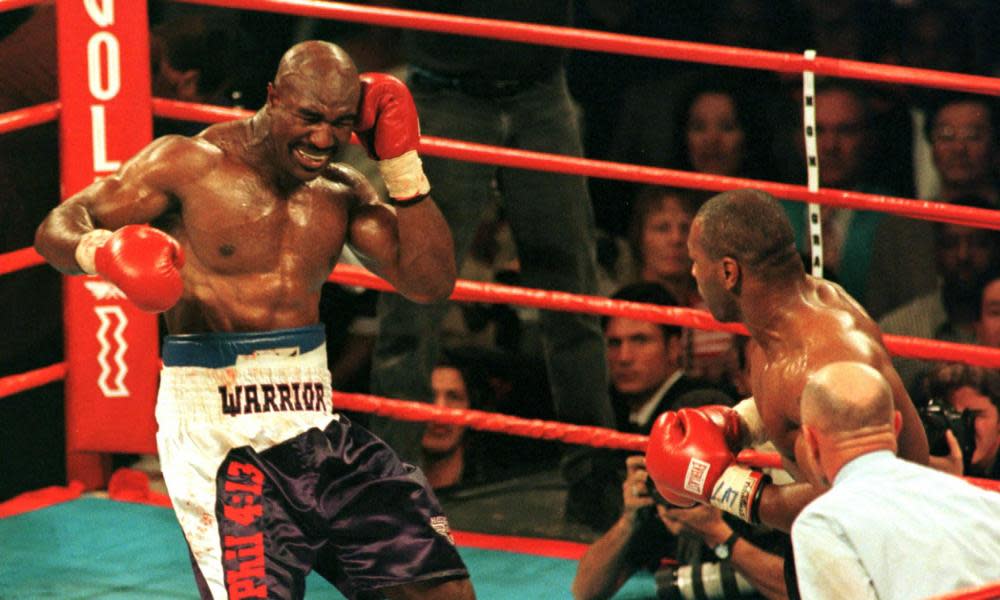My favourite game: Holyfield v Tyson, WBA heavyweight title fight 1997

At the risk of undermining this admirable exercise in nostalgia, “game” is a towering misnomer when attached to the peculiar art of rendering a fellow human being unconscious. As the late Brendan Ingle famously said, you don’t play boxing; he also said it is the only sport in which it is legal to kill someone.
There were no deaths the surreal Saturday night of 28 June 1997 at the MGM Grand in Las Vegas. No knockout, even. But there was much blood, most of it pouring from an inch-long open wound running along where the top of Evander Holyfield’s right ear once resided. It was the third round of his world heavyweight rematch against the convicted rapist Mike Tyson, whom he’d knocked out seven months earlier and who was having his sixth fight since being released from prison in 1995.
Tyson’s frothing mouth had ripped the cartilage from the champion’s ear in a single chomp, and he then spat it like a dummy into the fetid air. This was no game. It was not even boxing. It was jungle-grade anarchy. I was maybe 20 feet away, alongside similarly gob-smacked colleagues. “What the fuck was that?” a nearby American writer said. It was, I thought later, a spectacle that might have been lifted from a crimson-tinged Ralph Steadman illustration of one of Hunter Thompson’s wilder fantasies.
As the ear wriggled across the canvas into history, Holyfield, his face creased in agony, hopped around the ring like a child bitten by a wasp. Tyson was bleeding from an earlier butt to his head, and, enraged, came at his wounded prey again before the referee, Mills Lane, briefly stopped the carnage.
Tyson told Lane he had punched the ear cartilage off. “Bullshit!” shouted the referee, who knew what had happened, sure enough, but failed to process the enormity of the occasion. He called the doctor to inspect Holyfield’s wound and insanity as great as the crime itself ensued. While Lane, a Nevada court and boxing judge of long experience, wanted to disqualify Tyson, the doctor persuaded him Holyfield was fit to continue … so Lane took two points off the seething miscreant, who was now drowning in his own confusion, and on they boxed.
Defying all societal norms, it got worse. Tyson nipped the top of Holyfield’s left ear and Lane, perhaps inured to the gore, more likely confused to the point of dangerous incompetence, allowed them to complete the round. The pause brought the fight to an end, both men bleeding freely. As Lane said later: “One bite is bad enough, two bites is dessert.”

Like the stolen pushbike that inspired a young Cassius Clay to take up boxing (cough), the ear disappeared. Holyfield’s people claimed it was handed to them after the fight, they put it in an ice bag on his way to hospital in an ambulance, and then they... lost it!
Tyson went home to his understanding wife, Monica, who told him: “Everybody makes mistakes.” He smoked a joint and they went to sleep. David Letterman made jokes about pay-per-chew and Fight of the Ear.
Fifteen years later, Holyfield, forced out of his 109-room mansion and into bankruptcy through a string of bad relationships, auctioned the gloves he wore in the most infamous fight of modern times.
Not until his autobiography came out in 2013 did Tyson make a full confession. “I just wanted to kill him,” he said. “Anybody watching could see that the head butts were so overt. I was furious, I was an undisciplined soldier and I lost my composure.” He lost his composure? You could say that.
Tyson also lost $3m (2.5m), 10% of his purse. It came from a considerable pot. A capacity house of more than 18,000 brought in $17.3m; nearly two million American fans paid just under $100m in pay-per-view; closed circuit added $5.9m; international TV sales in 97 countries boosted the take by $21.2m.
The ear never turned up again.
Some game, boxing.

 Yahoo News
Yahoo News 
